As your body changes during pregnancy, are you finding it difficult to get a good night’s sleep? You may experience better sleep if you use a pregnancy pillow. We were saved by these pillows, or at the very least, they saved our sleep.
A pregnancy pillow not only makes it easier for us to sleep during pregnancy, but it also gets rid of some typical aches and pains. Do you know the proper way to use a pregnancy pillow for sleep? You can learn how to sleep with a pregnancy pillow by reading this article, so don’t worry.
What Is A Pregnancy Pillow?
A pregnancy pillow, also called a maternity pillow, is made specifically to support or relieve pressure on the entire body, not just the head and neck.
To accommodate a woman’s changing body throughout her pregnancy, they come in a variety of shapes and sizes and are typically larger than your typical pillow.
U-shaped Pregnancy Pillow
If you typically sleep on your back before becoming pregnant, that would be the best option. You will benefit from support on both sides of your body due to the U shape. This should prevent you from turning over while you’re sleeping.
J-shaped Pregnancy Pillow
If you typically sleep on your back before becoming pregnant and want to cuddle up with your partner in bed, this is the best position for you. The J-shaped pillow, in contrast to the U-shaped one, is open on one side so you can cuddle while getting support for your growing baby.
C-shaped Pregnancy Pillow
It would be best if you didn’t frequently toss and turn while you slept before becoming pregnant. You will have to flip it over every time you turn it over in bed because it isn’t double-sided. The C-shape offers the most comfortable if your stomach is particularly large or heavy.
Wedge-shaped Pregnancy Pillow
The best scenario for this is if you don’t require the most support and you experience extreme heat or cold while you sleep. For temperature regulation, while you sleep, the wedge is small and portable enough to be used with ice packs or heating pads.
How to Use A Pregnancy Pillow?
Using Full-length Pregnancy Pillows
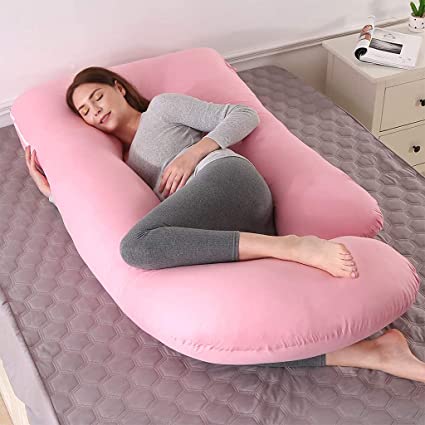
Using a full-length pregnancy pillow might be appropriate for you if:
- You lie on your side while you sleep.
- During sleep, you do not move around much.
- On your bed, you have extra space.
Place the pillow on your bed and encircle it with your arms to sleep with a full-length pregnancy pillow. Choose a comfortable position and pull the pillow close to you. Pregnancy pillows that are full-length are available in both straight and flexible styles.
Using C-shaped Pregnancy Pillows
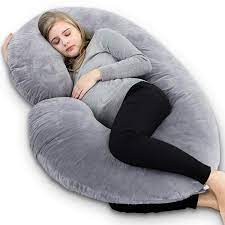
If any of the following apply to you:
- You have back pain.
- You desire all-around support.
- There is no turning over in bed.
- Your site is the way you sleep.
- Your bed has extra space.
When using a pregnancy C-shaped pillow, spread out the shape on the bed so you can easily climb inside.
The “C” should be positioned with its curve facing your back. Place the bottom of the pillow between your thighs while pulling the top of the pillow toward your head. To support your belly, the pillow’s entire bottom should extend up to it.
Using U-shaped Pregnancy Pillows
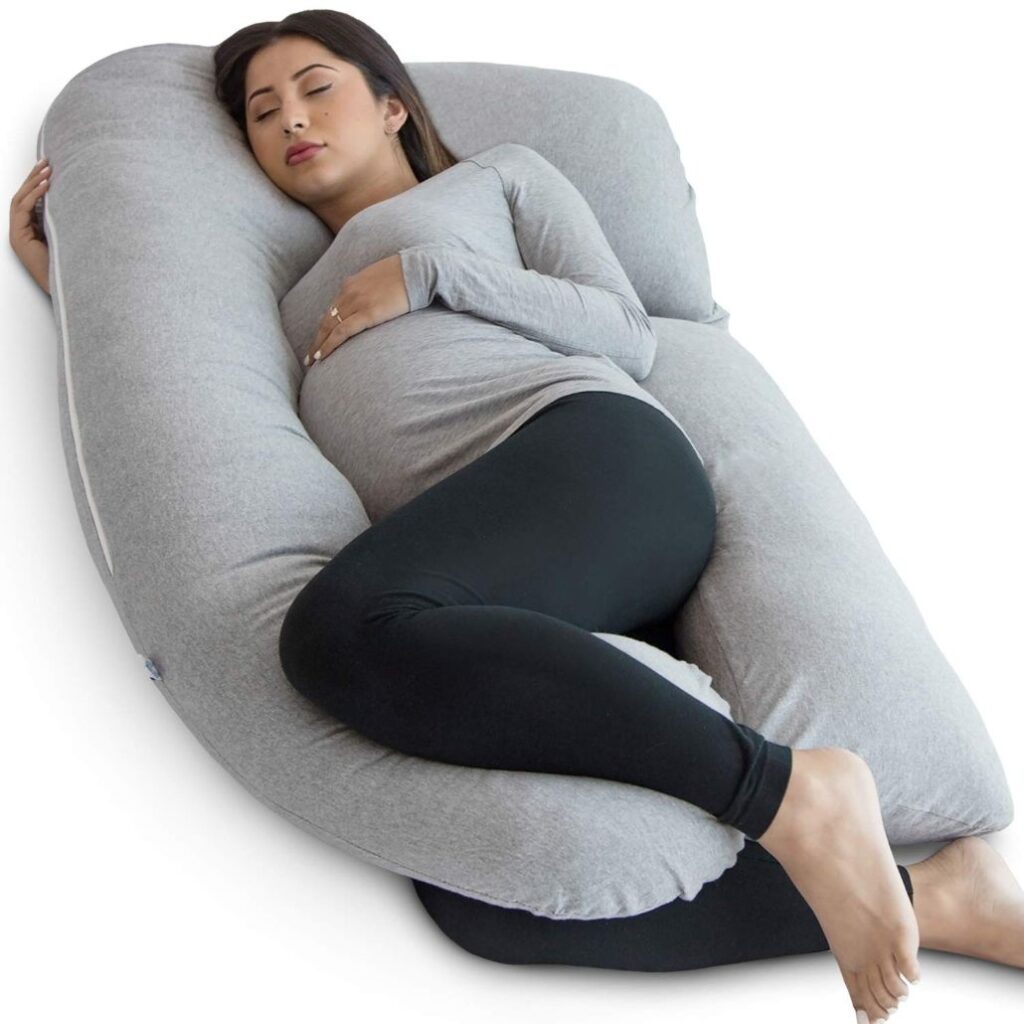
You ought to consider a U-shaped pregnancy pillow if:
- In the evening, you turn and turn.
- You prefer to sleep on your side or back.
- You’re seeking support for your entire body.
- On your bed, you have extra space.
U-shaped pregnancy pillows ease the transition from side to side just like C-shaped pregnancy pillows do. Cuddling with the pillow, you sit on one side of it. Turning over is all it takes to change sides.
For back sleepers, U-shaped pregnancy pillows are the best option because they provide support on both sides. Women who want support for their back, neck, and head can tuck themselves right into the center.
Using Inflatable Pregnancy Pillows
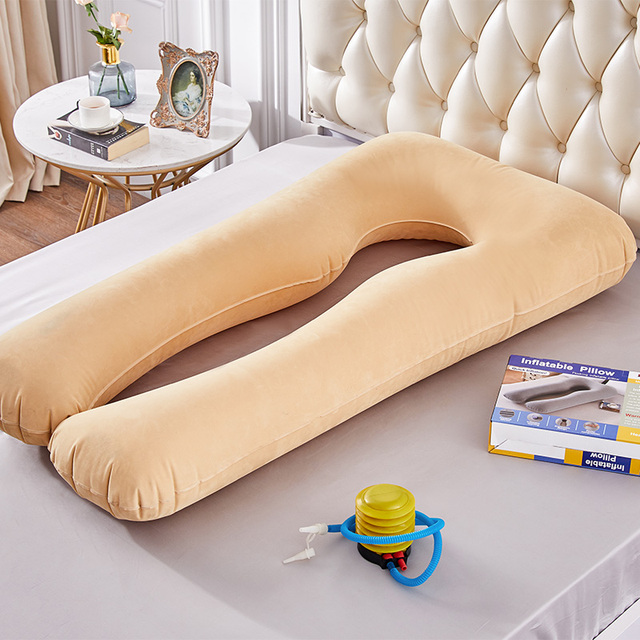
You should consider purchasing an inflatable pregnancy pillow if:
- Your third trimester has begun.
- On your stomach, you prefer to sleep.
- You want to change how much support you provide.
An inflatable pregnancy pillow requires a little extra effort, but it’s a great option if you used to sleep on your stomach before becoming pregnant.
Similar to an air mattress, inflatable pregnancy pillows are made of various materials. They frequently come with a pump, which makes installation simple. Just fill the pillow with air until it feels cozy.
Lay down on top of the pillow after it has been inflated, tucking your growing baby into the opening. You might want to cover your pillow with a blanket or towel for added comfort, depending on the material it is made of.
Sleeping With A Pregnancy Wedge
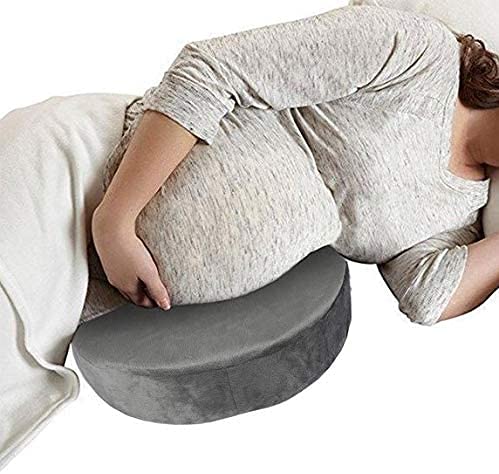
You ought to consider a pregnancy wedge if:
- Localized assistance is required.
- Your financial resources are limited.
- In the bed, there is not much extra space.
- Versatility is what you seek.
For pregnant women who have trouble sleeping, a pregnancy wedge is a fantastic, affordable option. Wedges typically come in two different shapes: circles and triangles. A pregnancy wedge is easy to use: place the wedge underneath the area where you need support, and rest easy.
Why Is Sleeping Harder During Pregnancy?
Every woman’s body goes through a lot of physical changes during pregnancy. Some of those adjustments can make it harder to get to sleep or stay asleep.
Hormones
Hormones contribute to altered sleep patterns, as they do with most pregnancy problems. The hormone progesterone can make you sleepy during the day, while other hormones can make your dreams vivid and strange.
Some hormones cause your muscles to contract, which causes discomfort and snoring at night.
Heartburn
Heartburn, a distressing burning in the chest and esophagus, is another symptom of hormones. Expectant mothers often have trouble sleeping due to heartburn.
Later in pregnancy, heartburn can also be caused by your growing baby putting pressure against the stomach, pushing digestive acids up your esophagus.
Stress
If you’re anything like us, you might find it difficult to stop worrying about the impending arrival of your baby. How will labor go? The worst-case scenario Do I have everything I need? Experience has taught us that a mother can spend hours thinking about these things.
A regular sleep schedule is essential for both your health and the health of your developing child. Even though it seems impossible, sleep needs to be a top priority.
Physical Uncomfort
You’ll find it more difficult to relax, both at night and during the day, as your new baby grows and takes up more space inside your belly. Using a pregnancy body pillow is a smart move to get comfortable and get some rest if you’re experiencing this kind of discomfort.
Sleeping Positions For Pregnant Women
It appears that pregnant women must follow a set of specific guidelines when it comes to sleeping. Here are some suggestions for good and bad sleeping positions for expectant women.
How Not To Sleep While Pregnant
It should go without saying that you shouldn’t sleep on your stomach. Once your stomach bulges and you start to show, doctors specifically advise against lying on your stomach.
Sleeping on your back is also not recommended because it puts pressure on your intestines and major blood vessels, which can lead to breathing problems, backaches, and low blood pressure, all of which can be harmful to your unborn child.
The Best Way To Sleep While Pregnant
Sleeping on your side, particularly your left side, is advised by the American Pregnancy Association (APA). Particularly when your body is sacrificing space for your organs to accommodate your baby, sleeping on your right side can put additional pressure on your liver.
By sleeping on your left, you can avoid this problem and improve your circulation, which will help the baby’s blood flow.
We are aware that having to sleep on the same side every night may make you feel restless. The best way to ensure the safety of both you and your unborn child during pregnancy is to sleep on your side.




